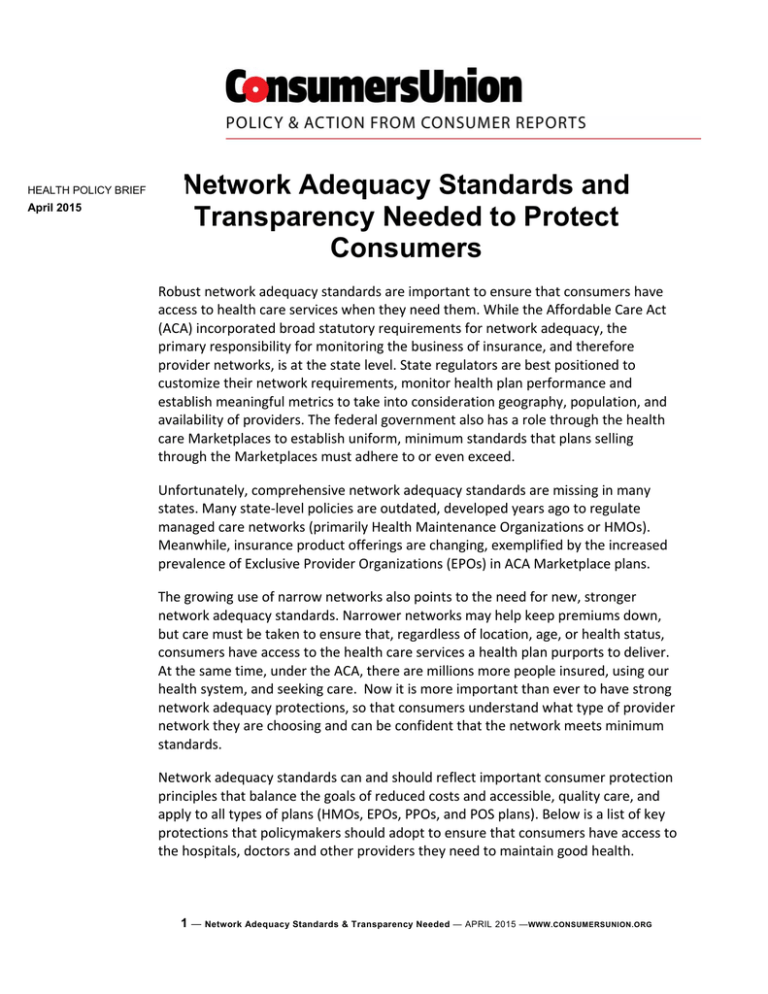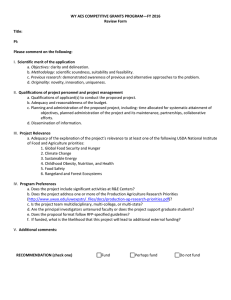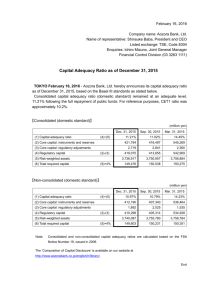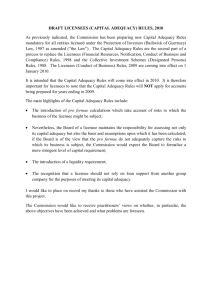Network Adequacy Standards and
advertisement

HEALTH POLICY BRIEF April 2015 Network Adequacy Standards and Transparency Needed to Protect Consumers Robust network adequacy standards are important to ensure that consumers have access to health care services when they need them. While the Affordable Care Act (ACA) incorporated broad statutory requirements for network adequacy, the primary responsibility for monitoring the business of insurance, and therefore provider networks, is at the state level. State regulators are best positioned to customize their network requirements, monitor health plan performance and establish meaningful metrics to take into consideration geography, population, and availability of providers. The federal government also has a role through the health care Marketplaces to establish uniform, minimum standards that plans selling through the Marketplaces must adhere to or even exceed. Unfortunately, comprehensive network adequacy standards are missing in many states. Many state‐level policies are outdated, developed years ago to regulate managed care networks (primarily Health Maintenance Organizations or HMOs). Meanwhile, insurance product offerings are changing, exemplified by the increased prevalence of Exclusive Provider Organizations (EPOs) in ACA Marketplace plans. The growing use of narrow networks also points to the need for new, stronger network adequacy standards. Narrower networks may help keep premiums down, but care must be taken to ensure that, regardless of location, age, or health status, consumers have access to the health care services a health plan purports to deliver. At the same time, under the ACA, there are millions more people insured, using our health system, and seeking care. Now it is more important than ever to have strong network adequacy protections, so that consumers understand what type of provider network they are choosing and can be confident that the network meets minimum standards. Network adequacy standards can and should reflect important consumer protection principles that balance the goals of reduced costs and accessible, quality care, and apply to all types of plans (HMOs, EPOs, PPOs, and POS plans). Below is a list of key protections that policymakers should adopt to ensure that consumers have access to the hospitals, doctors and other providers they need to maintain good health. 1 — Network Adequacy Standards & Transparency Needed — APRIL 2015 —WWW.CONSUMERSUNION.ORG Policymakers should establish robust standards to ensure timely and meaningful access to the range of essential health benefits The ACA requires a provider network that is sufficient in number and types of providers to ensure that all services will be accessible without unreasonable delay. 1 Standards defining “sufficient” “accessible” or “unreasonable,” however, are left to state policymakers. In California, state laws currently interpret “unreasonable” delay to mean that a consumer should not have to wait more than 10 business days to get a non‐urgent appointment with a primary care physician. 2 In Delaware, “sufficient” is defined by an enrollee‐to‐physician ratio. 3 Many states leave timely and meaningful access standards to be defined by each insurer. 4 Consumers Union urges federal policymakers to require states to set standards that all their health plans must comply with, in the categories outlined below. Further, where appropriate, states should set specific and measurable standards. At a minimum, all states should set specific geographic and timely access standards To that end, state policymakers must: A. Establish robust minimum standards to ensure that consumers have meaningful access to providers, which means: i. Geographic access: Maximum travel times and/or distance standards (miles) that patients can be required to travel to access in‐network providers. The specific metrics to establish the travel times can be unique to the state. States may choose to create different geographic standards for primary care providers, as compared to specialists. Any exceptions to the geographic access standard should be clear at the time of application and in all enrollment materials. ii. Timely access: Maximum appointment wait‐time standards for in‐ network providers, distinguishing between urgent and non‐urgent care. iii. Minimum number of providers: States should set standards for minimum enrollee‐to‐provider ratios. States may need flexibility to establish ratios that vary by geographic area or provider type. Most importantly, states should require that only contracted, in‐network providers be counted toward meeting the ratio; that is, health plans cannot count out‐of‐network providers toward meeting the enrollee‐to‐ provider ratio standard. 1 2 45 Code of Federal Regulations §156.230. 28 California Code of Regulations §1300.67.2.2(c)(5)(C) 3 For example, the state of Delaware requires 1 primary care physician for every 2,000 patients for their QHP products http://www.delawareinsurance.gov/health-reform/DE-QHP-Standards-PY2015-May2014-v1.pdf 4 For example, Colorado allows insurers to set provider-enrollee ratios according to "reasonable criteria." As cited in McCarty, S & Farris, M, ACA Implications for State Network Adequacy Standards, Robert Wood Johnson Foundation, August 2013 citing CCR § 25.5-5-403; 3 CCR 702-4. 2 — Network Adequacy Standards & Transparency Needed — APRIL 2015 —WWW.CONSUMERSUNION.ORG iv. Accepting new patients: The standard should require that providers report to health plans in a timely manner (at least monthly) whether or not they are accepting new patients. During any audit, spot check or other monitoring activity, network adequacy can only be fulfilled by providers in the network who are actually identified as accepting new patients; that is, those providers in the network who are closed to new patients should not be counted toward the health plan’s ability to meet the network adequacy standard. B. Require health plans to comply with these standards, with provisions for auditing and oversight by the state, as described below. New standards should be accompanied by strong remedies for consumers when they cannot access in‐network care State policymakers should ensure that: A. Consumers have access to out‐of‐network providers at in‐network rates. (That means that when in‐network services are not available, consumers would have in‐network cost‐sharing, even for out‐of‐network providers). Providers would be prohibited from charging out‐of‐network cost‐sharing and prevented from balance billing in these circumstances, including but not limited to: i. Emergency care from an emergency room, regardless of whether the facility or the providers are in or out of network. ii. Non‐emergency primary or specialty care when in‐network providers are not available under the meaningful access standards noted above (specifically, geographic access and timely access). iii. Out‐of‐network providers supplying care through an in‐network facility. B It is clearly defined how out‐of‐network providers and health plans cover the remaining charges when in‐network services are not available. In all instances, consumers should be held harmless. C. There are strong exception protections, including clear and transparent expedited external appeals processes, for individual consumers who seek out‐of‐network care. D. Health plans have a mandated referral process, for when in‐network providers refer patients to out‐of‐network providers for non‐urgent procedures. The health plan and/or provider must provide plain language information to the patient, at least 5 days in advance, about the implications of a referral out‐of‐network and get a signed document from the consumer indicating that the patient was informed of the financial implications of seeing an out‐of‐network provider. 3 — Network Adequacy Standards & Transparency Needed — APRIL 2015 —WWW.CONSUMERSUNION.ORG Standards should clearly delineate and uphold federal non‐discrimination protections State standards should ensure that: A. People with disabilities have access to care. B. Limited English proficient (LEP) consumers have access to information about health care providers in their own language including provider directories, and other network information. Policymakers must require transparent and accessible information about provider networks for consumers Consumers continue to face challenges in understanding the breadth or restrictiveness of product networks and in determining which doctors are in plan networks. Indeed, provider networks are one of the least standardized and most difficult‐to‐understand elements of health plans. Specific problems consumers face include navigating provider directories online, assessing the accuracy of provider directories, effectively searching for providers across plans, comparing overall plan networks, and understanding plans’ policies regarding in‐network and out‐of‐ network services. Yet provider participation information is crucial for choosing a plan and for selecting a provider without incurring burdensome out‐of‐network costs. To remedy current problems and make consumers more effective shoppers, policymakers must take action to hold insurers and providers accountable for making timely and accurate network information available to consumers. States should establish standards that require health plans to make available reliable, easily accessible, and searchable provider directories. 5 State policymakers should require that: A. Provider directories are available without a log‐in or entering account information and should include clear, reliable information written in plain language identifying: i. Whether each provider is accepting new patients; ii. Each provider’s ability to serve people who are limited English proficient (LEP) and people with disabilities; iii. Clinical staffs’ language capabilities; 5 For more detailed consumer protections regarding provider directories, see, “Making Provider Directories Meaningful to Consumers “ available at http://consumersunion.org/wpcontent/uploads/2014/12/Provider_Directories_principles_1214.pdf 4 — Network Adequacy Standards & Transparency Needed — APRIL 2015 —WWW.CONSUMERSUNION.ORG iv. Affiliations with independent practice associations (IPAs) and hospitals/other facilities (including admitting privileges, including a list of participating hospitals by county/geographic region.) B. Provider directories are formatted to facilitate incorporation into integrated provider directories that can be hosted by health care Marketplaces or other third parties. C. Provider directories allow users to search by uniform distance categories (e.g., 5 miles, 25 miles, 50 miles from a zip code of address), so consumers can find providers based on distance from their home or workplace. D. For health plans that have tiered networks, there is a clear indication that the tiers exist, plain language explanation of the significance of the tiers (including cost implications), and clear information about which providers are in which tier. E. Online provider directories are updated at least weekly, with the 5 year goal of phasing in updates to within 48 hours of the change in status. The website must prominently display the date of the most recent update. F. Provider directories display an accuracy score for prior 3 years, which would be arrived at through regulatory monitoring and enforcement (as identified below). States should ensure there are standards for transparency regarding tiered networks and out‐of‐network cost‐sharing Regulators should require: A. Upfront disclosure of tiering and out‐of‐network cost‐sharing policies, including: i. Information about tiering, if applied to in‐network providers, including clear information about differences in cost‐sharing between the tiers. ii. Disclosure of consumers’ potential out‐of‐pocket costs when obtaining out‐of‐network services with coverage examples and illustrations that show how it will work. iii. Disclosure of the availability of out‐of‐network providers at in‐ network prices when no in‐network providers are available, including necessary contact information, so patients can easily access out‐of‐ network providers in these situations: ● When authorization is sought for particular services, insurers must tell their members whether those providers are in‐network, how much the plan will reimburse, and for out‐of‐network providers, how the reimbursement compares to the usual, customary, and reasonable (“UCR”) fee. 5 — Network Adequacy Standards & Transparency Needed — APRIL 2015 —WWW.CONSUMERSUNION.ORG ● If an insurer reimburses for out‐of‐network services, the insurer must give the patient examples of how much they will pay for common medical procedures out‐of‐network and how those amounts compare to typical charges in‐network. B. Health plans publicly report summary measures to include, at a minimum: i. The overall adequacy of the network – i.e., a relative measure of the network through a state‐developed, uniform label such as “broad”, “narrow,” or “ultra‐narrow” to signal to consumers the scope of the network compared to other offered products. For example, this could be based upon the percent or number of providers in network, how many are accepting new patients, etc. ii. Standards used to establish the network ‐ clear and transparent information about the insurer’s provider selection criteria, including how providers are grouped into tiers and particularly selection methods for ranking providers within each tier. New standards should be accompanied by strong remedies for consumers when health plans fail to provide sufficient transparency or state regulators fail to provide sufficient oversight of network adequacy A. Standards should allow consumers to switch insurers or plans mid‐year if a designated provider or providers leave the plan. Enrollees should be able to designate providers they intend to use when they start the plan. Later, if the identified providers leave the plan mid‐year, state standards should provide for a new special enrollment trigger for these consumers. B. Insurers shall notify current enrollees seen by a provider in the past year when that provider leaves the network for any reason. C. Directories should include disclosure of consumers’ rights to network adequacy and timely access. State Agency Oversight Responsibilities Federal policies should require that states implement rigorous monitoring and oversight systems to assure that health plans are meeting the network adequacy standards. There must be adequate funding for this activity, through federal grants, state budgets, or other sources. States must collect, analyze, use, and publicly report data to enforce network adequacy standards Regulators must: A. Collect and analyze, before the plan year and several times during the plan year, the following data for each health plan: i. Geographic access 6 — Network Adequacy Standards & Transparency Needed — APRIL 2015 —WWW.CONSUMERSUNION.ORG ii. Timely access iii. Enrollee‐to‐provider ratios iv. Volume and type of out‐of‐network services used by enrollees, when applicable B. Develop and publicly report an accuracy score for each health plan’s provider directory, including oversight to ensure that health plans display the accuracy score on their provider directory. C. Provide public information on the regulator’s website regarding state policies on network adequacy, including in‐network and out‐of‐network care, rules on tiered networks, standards for cultural and language access, information about exception processes and appeals. D. Conduct ongoing robust monitoring of provider directories to: i. Require that health plans report provider directory audits to regulators. ii. Conduct independent, third party provider directory audits. iii. Undertake secret‐shopper spot checks as needed to ensure information health plans provide to regulators is consistent with consumer experience. iv. Provide uniform public reporting of findings from any of the above. State standards should require health plans to undertake public reporting and provider monitoring activities Health plans should be required to: A. Monitor at least monthly provider participation and churn in each plan’s network. B. Create mechanisms to ensure compliance with reporting of data by providers. C. Develop and implement corrective action plans when providers do not adhere to network adequacy requirements, including incorporating such standards in contracts with providers (for example, contract language that requires providers to undertake timely reporting when they are no longer accepting new patients), and allowing enrollees to change plans if correction action not taken in the time frame required. D. Monitor primary care providers’ assigned membership monthly to ensure that they are not exceeding the enrollee‐to‐provider ratio. If the ratio is beyond the limit, the health plan must indicate on the provider directory that the doctor is not accepting new patients. Policymakers need to provide state regulators with powers to enforce network adequacy standards In order to make network adequacy standards meaningful to consumers, state regulators should have the power and the resources to enforce the standards and to 7 — Network Adequacy Standards & Transparency Needed — APRIL 2015 —WWW.CONSUMERSUNION.ORG remedy any violations of the standards. Enforcement not only requires clear delegation of authority, but also adequate financial resources to undertake oversight and monitoring. In most cases, when health plans fail to meet network adequacy standards, remedies will focus on curing the deficits, rather than applying punitive measures. But in the rare instances where misconduct or flagrant violations occur, state policymakers should have authority to impose sanctions, penalties and/or fines. Regulators should have explicit authority to: A. Establish corrective action plans to increase provider participation/add providers to the network in specialty areas or geographic areas when they deem health plan networks insufficient. B. Develop corrective action plan policies, which should include the power to freeze new enrollment in a plan if the insurer is not meeting the network adequacy standards. C. Impose penalties, fines or other financial consequences to violations that are not remedied through other corrective measures, including allowing enrollees to change plans mid‐year. Julie Silas is the primary author of this set of recommendations. She can be reached at jsilas@consumer.org. 8 — Network Adequacy Standards & Transparency Needed — APRIL 2015 —WWW.CONSUMERSUNION.ORG



